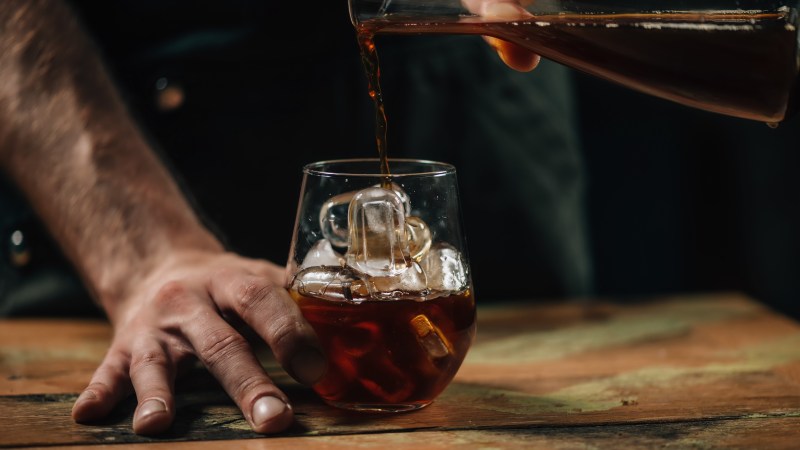Whenever I visit a coffee shop or find myself in a coffee drive-through, my mind runs through dozens of orders. A cold brew is an excellent order for when I’m in the mood for something to sip on slowly, but a shot of espresso hits the spot when I want something fast and slightly bitter. Though I love both coffee drinks, there’s a right time and a place to order a cold brew vs. an espresso. Below, let’s compare cold brew vs. espresso regarding acidity, caffeine content, and taste. Next time you find yourself unsure which to order you’ll go with, you’ll remember these differences.
Brewing time and method

According to La Colombe Coffee Trainer Rachael Guerrieri, “Cold brew and espresso are as different as you can get. Cold brew is a coarse grind with cold or room-temperature water. During the brewing process, the coffee and water spend a ton of time together to get the perfect brew – think 8-24 hours! On the other hand, espresso is a super fine grind, made with really hot water in about 25 seconds.” Guerrieri is La Colombe’s East Coast trainer and has over 15 years of experience as a barista and coffee trainer.
The brewing process for these two coffee drinks is entirely different. Guerrieri explains that making cold brew involves steeping coarsely ground coffee in cold or room-temperature water for a long process (generally overnight). Cold brew isn’t the type of drink you can whip up in a jif, so you’ll want to think ahead if you’re making it home. Meanwhile, brewing a hot espresso shot requires using an espresso machine and finely ground coffee. The pressurized brewing process of an espresso maker yields a super-concentrated shot of espresso with a layer of crema on top. The differences in brewing time and methods are key factors that make these drinks taste so different.
Pre-made cold brew or cold brew concentrates are also good options if you don’t have the time or patience to make cold brew coffee at home. However, I recommend carefully measuring your cold brew concentrate to control your caffeine intake (as this stuff can be super strong).
Taste and acidity

Since cold brew is brewed slowly through a steeping process, the slowly extracted flavor results in a smoother, less acidic taste. Alternatively, brewing an espresso is a fast process with a rapid extraction of flavors, resulting in a lighter, more bitter taste. The less acidic taste of cold brew coffee makes it a better option for people who prefer low-acid coffee due to sensitive stomachs. The slow extraction process of cold brew coffee extracts fewer oils than brewing a shot of espresso.
Let’s suppose I’m going to have coffee on an empty stomach. In that case, cold brew coffee is much more gentle on my stomach than drinking a straight shot espresso (although I recommend avoiding coffee on an empty stomach altogether, if possible).
Is espresso stronger than cold brew?

Comparing cold brew vs. espresso in terms of strength leads to a bit of a gray area, as the answer depends on the serving size. If you compare one ounce of cold brew to one ounce of espresso, the espresso is much stronger. One ounce of espresso (equivalent to one shot) contains about 64 mg of caffeine, whereas one ounce of cold brew generally has maybe 15-20 mg of caffeine. However, I’ve never seen anyone consume one ounce of cold brew. Cold brew is usually enjoyed in larger serving sizes, such as 8 to 16 ounces. While it’s possible you could have one ounce of cold brew, it’s probably pretty unrealistic.
Since the size of a cold brew coffee order varies, it’s hard to say precisely how many espresso shots you’d need to equal the same amount of caffeine as a cold brew. On average, a 16-ounce cold brew contains about 200 mg of caffeine. By this math, you’d have to consume about three shots of espresso for about the same caffeine serving.
Cold brew vs. espresso: Which should you order?

We’ve already established cold brew and espresso as two vastly different coffee drinks. Yet, this doesn’t immensely help you decide which to order when you’re standing at the coffee counter and it’s time to place your order. Ultimately, choosing which to order comes down to personal preference. There’s no “better” order between cold brew and espresso.
If you’re new to drinking coffee (or are craving something cold and refreshing), I recommend starting with a cold brew order. Drinking espresso, especially in the form of straight espresso shots, is an acquired taste. If you like the taste of espresso and want something different than a cold brew (or if cold brew isn’t available), ordering an iced Americano is probably your next best option.




